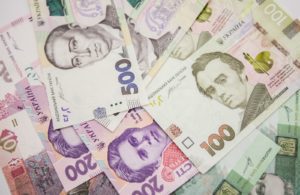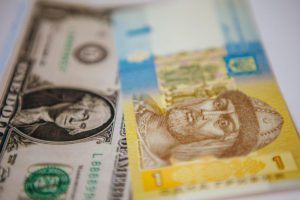The hryvnia to U.S. dollar exchange rate in the interbank foreign exchange market on July 31 strengthened to UAH 24.9845/$1 from UAH 25.0919/$1. The deputy chairman of the board of First Investment Bank, Vladyslav Kravets, told Interfax-Ukraine that the exchange rate in the interbank market on July 31 started with UAH 24.95-24.98/$1, and by the middle of trading it was UAH 25.075-25.115 per $1.
According to him, the steady trend to the hryvnia exchange rate strengthening due to the growth of non-residents’ investments in hryvnia-denominated government domestic loan bonds will continue in the near future.
“The seasonal growth in foreign currency earnings from agricultural exports has not gone beyond the figures that were last year or the year before, therefore the main driver for the current strengthening of the hryvnia exchange rate is the inflow of foreign investment in hryvnia-denominated government bonds. In the near future, the hryvnia exchange rate will continue to strengthen. The expected mitigation of the monetary policy of the Federal Reserve System and the European Central Bank, in response to a slowdown in economic growth, will stimulate the flow of investor funds to emerging markets, including Ukraine. If the NBU does not actively absorb the surplus of currency from the market to reserves, the hryvnia exchange rate will soon aim at around UAH 24/$1,” the banker explained.
Since the beginning of the year, the hryvnia exchange rate has strengthened by almost 10%, in particular by almost 4% over the last ten days.
The last time the hryvnia to U.S. dollar exchange rate was below UAH 25/$1 on August 12, 2016.

The hryvnia will continue strengthening in the short term, according to bankers polled by Interfax-Ukraine. “It is likely that soon we will see UAH 25.5 per $1,” senior analyst at Raiffeisen Bank Aval Mykhailo Rebryk has said. According to him, the main factors of the observed strengthening of the hryvnia exchange rate are sales of currency by non-residents for the purchase of government domestic loan bonds and seasonal sales by large exporters of currency earnings from the sale of a new crop.
Rebryk believes that fundamental risks for the hryvnia exchange rate in the short term are insignificant.
“The trade balance had a slight deficit in May, EUR1 billion from eurobond placement in June is likely to cover the cumulative deficit of the financial account, and on the current account receipts from labor migrants cover trade deficit,” he said.
The expert believes that the parliamentary elections in July will not significantly affect the hryvnia exchange rate.
“Given the fact that sociological ratings accurately reflected the situation in the run-up to the presidential elections, we can expect that the results of parliamentary elections will generally correspond to the results of polls. And what is predictable, it is laid down in the expectations of market participants. Therefore, we do not expect a significant impact of the election results on the market,” he said.
At the same time, according to Rebryk, the further expansion of the trade deficit and peak payments on the state debt in September will create certain fundamental prerequisites for weakening the hryvnia exchange rate by the autumn.
Director for Treasury at Bank Credit Dnepr Oleh Kurinny said that in the absence of economic and political shocks, the hryvnia exchange rate in July will be in the range of UAH 25.90 – 26.40/$1. According to him, further exchange rate trends will be determined by the vectors of foreign, economic and monetary policies, the course of the parliamentary election campaign and cooperation with international financial institutions, the level of investor interest in government bonds, world commodity and stock market conditions, the volume of export income and earnings from labor migrants.
“Seasonal factors, of course, have a certain impact on the volume and structure of export-import transactions, but it is not fatal and can be partially minimized by the effective preventive actions of the regulator in the field of monetary policy and linking hryvnia liquidity,” he added.
According to Kurinny, the key factors that contributed to the strengthening of the hryvnia exchange rate below the psychological mark of UAH 26/$1 were: the preservation of the NBU key policy rate in June at 17.5% as a signal of maintaining high yield of government bonds and deposit certificates – tools of hryvnia liquidity; the results of the latest auctions of the Finance Ministry on placement of government bonds, which confirmed interest in Ukrainian securities, having an additional stabilizing effect on the mood of market players and increasing the supply of currency; complete abolition of the mandatory sale of foreign currency income by the business; the continued seasonal prevalence of currency supply in the cash market; active participation of the regulator with the purchase of surplus foreign currency supply, smoothing exchange rate dynamics, but supporting the general revaluation trend.

The enormous purchasing power of the dollar in Ukraine is confirmed by The Economist’s latest Big Mac Index. In a survey of 50 major economies, plus the Euro zone, Ukraine has the second most undervalued currency, bested only by Russia.
In a gauge of purchasing power parity, the hryvnia is 65% below where the dollar exchange rate should be. Instead of 28 hryvnia to the dollar, the Index says the hryvnia exchange rate should should be about 10 hryvnia to one dollar.
By comparison, the Russian ruble is 70% undervalued, the Turkish lira is 64% undervalued, and the Moldovan leu is 59% undervalued.